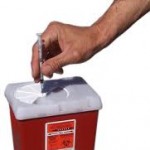Gastroparesis, also called delayed gastric emptying, is a disorder in which the stomach takes too long to empty its contents. Normally, the stomach contracts to move food down into the small intestine for digestion. The vagus nerve controls the movement of food from the stomach through the digestive tract. Gastroparesis occurs when the vagus nerve is damaged and the muscles of the stomach and intestines do not work normally. Food then moves slowly or stops moving through the digestive tract.
Changing your eating habits can help control gastroparesis. Your doctor or dietitian may prescribe six small meals a day instead of three large ones. If less food enters the stomach each time you eat, it may not become overly full. In more severe cases, a liquid or pureed diet may be prescribed.
The doctor may recommend that you avoid high-fat and high-fiber foods. Fat naturally slows digestion—a problem you do not need if you have gastroparesis—and fiber is difficult to digest. Some high-fiber foods like oranges and broccoli contain material that cannot be digested. Avoid these foods because the indigestible part will remain in the stomach too long and possibly form bezoars.
A dietitian might suggest that you try to:
- Eat smaller meals more frequently.
- Eat low-fiber forms of high-fiber foods, such as well-cooked fruits and vegetables rather than raw fruits and vegetables.
- Choose mostly low-fat foods, but if you can tolerate them, add small servings of fatty foods to your diet.
- Avoid fibrous fruits and vegetables, such as oranges and broccoli, that are likely to cause bezoars.
- If liquids are easier for you to ingest, try soups and pureed foods.
- Drink water throughout each meal.
- Try gentle exercise after you eat, such as going for a walk.
- Find other natural remedies that may help.
Implanting an electrical device to control the stomach muscles.
Electrical gastric stimulation uses an electric current to cause stomach contractions. Working much like a heart pacemaker, this stomach pacemaker, consisting of a tiny generator and two electrodes, is placed in a pocket that surgeons create on the stomach’s outer edge. Stomach pacemakers have been shown to improve stomach emptying and reduce nausea and vomiting in some people with gastroparesis.
Connecting with others.
 Gestational (jes-TAY-shun-ul) diabetes is diabetes that is found for the first time when a woman is pregnant. Out of every 100 pregnant women in the United States, three to eight get gestational diabetes. Diabetes means that your blood glucose (also called blood sugar) is too high. Your body uses glucose for energy. But too much glucose in your blood can be harmful. When you are pregnant, too much glucose is not good for your baby. (Spanish)
Gestational (jes-TAY-shun-ul) diabetes is diabetes that is found for the first time when a woman is pregnant. Out of every 100 pregnant women in the United States, three to eight get gestational diabetes. Diabetes means that your blood glucose (also called blood sugar) is too high. Your body uses glucose for energy. But too much glucose in your blood can be harmful. When you are pregnant, too much glucose is not good for your baby. (Spanish)





